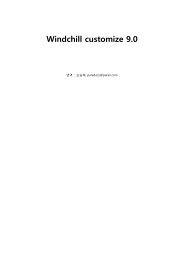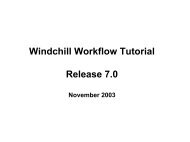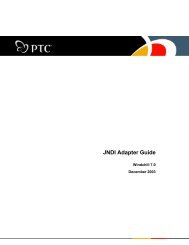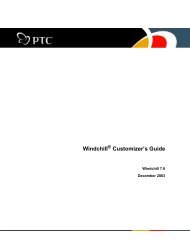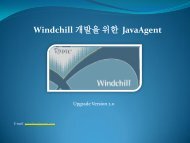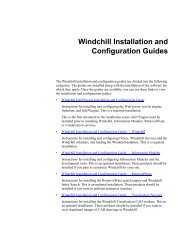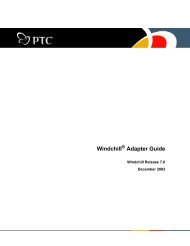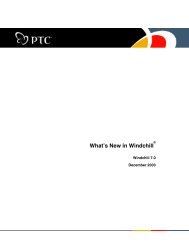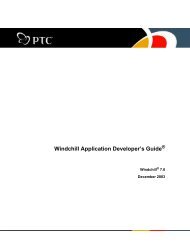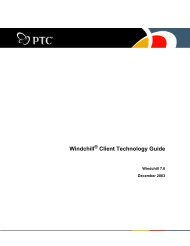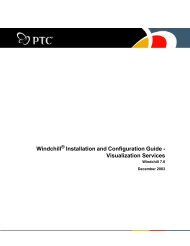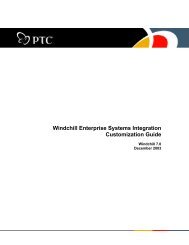Windchill System Administrator's Guide
Windchill System Administrator's Guide
Windchill System Administrator's Guide
You also want an ePaper? Increase the reach of your titles
YUMPU automatically turns print PDFs into web optimized ePapers that Google loves.
Maintenance Release, its important to carefully manage your changed files. Be<br />
aware that each time you install a <strong>Windchill</strong> Service Pack you will have to<br />
manually incorporate any PTC updates into your modified files. For detailed best<br />
practices on managing your site modifications, see the <strong>Windchill</strong> Solutions R7.0<br />
Maintenance Information paper that is available from the PTC Technical Support<br />
Web site. The remainder of this section gives a brief overview of the <strong>Windchill</strong><br />
Service Pack installation process and provides notes on areas where best practices<br />
will be provided.<br />
By carefully managing site modifications following best practices, you can<br />
greatly improve the efficiency of the <strong>Windchill</strong> Service Pack installation and<br />
decrease production down time. It should be noted that just as in past releases,<br />
PTC recommends that you use a separate test system to prepare and validate the<br />
updates before installing them into production. This will help ensure minimal<br />
downtime during the installation into the production system. It is also advisable<br />
to perform a backup of the product installation directory prior to performing the<br />
installation.<br />
Installation Process for the <strong>Windchill</strong> Service Pack<br />
The <strong>Windchill</strong> Service Pack installation image is the delivery vehicle for updates<br />
to over half of the <strong>Windchill</strong> 7.0 products, including <strong>Windchill</strong> Foundation &<br />
PDM, <strong>Windchill</strong> ProjectLink, <strong>Windchill</strong> PDMLink, Info*Engine, and Information<br />
Modeler. It also delivers updates to a subset of the Workgroup Managers and<br />
gateway products. For these products, there are updates for both English and<br />
language specific versions. The specific list of products covered is provided<br />
through the documentation accompanying the Maintenance Release.<br />
Updates are cumulative meaning that once a correction has been delivered in one<br />
version of the <strong>Windchill</strong> Service Pack, it is included in all future versions of the<br />
<strong>Windchill</strong> Service Pack. Each version of the <strong>Windchill</strong> Service Pack is identified<br />
with a different datecode.<br />
When the <strong>Windchill</strong> Service Pack executes 1 , it copies new and updated files from<br />
PTC and performs various housekeeping operations (such as registering the<br />
installation of the updates, propagating XCONF file updates, re-building class<br />
files for enumerations that have changed, re-building client JAR files, and so on).<br />
In order to prevent the <strong>Windchill</strong> Service Pack installer from simply over-writing<br />
your site-modified files with updates from PTC, the installer runs two modes:<br />
• Preliminary Installation. In the first execution, you can install the <strong>Windchill</strong><br />
Service Pack into your test system where you can examine PTC updates and<br />
incorporate them into PTC files that you have modified. On the test system,<br />
you can then validate that the PTC updates, site modifications, and<br />
1. This description applies to when the <strong>Windchill</strong> Service Pack is executed for the <strong>Windchill</strong><br />
Installation directory where the <strong>Windchill</strong> Method Server is hosted. For other products, the<br />
installer primarily just copies in updated files and there are none of the special processing<br />
regarding site modifications are required.<br />
1-42 <strong>Windchill</strong> <strong>System</strong> Administrator’s <strong>Guide</strong>




